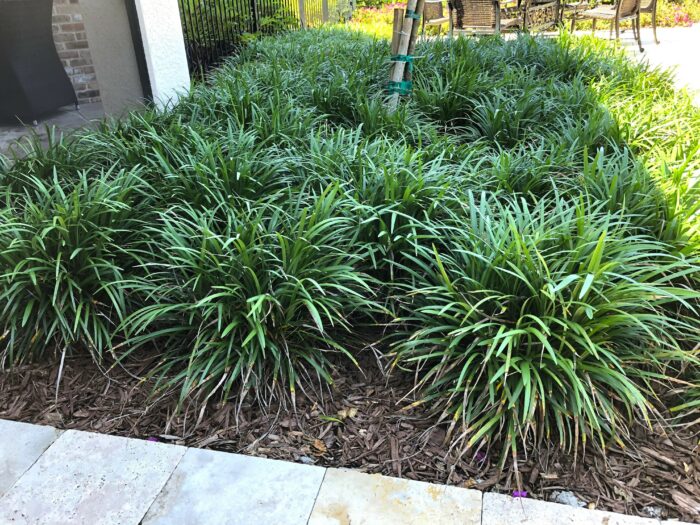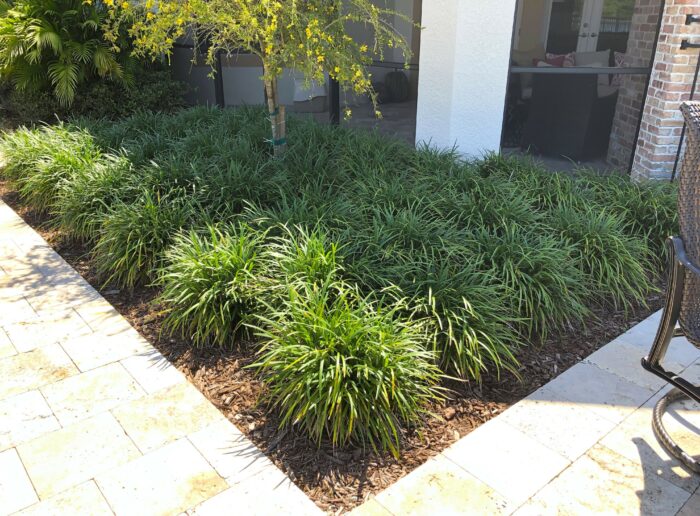Liriope retains its glamorous green with proper care.

“My liriope grass looked absolutely great when first planted, but now the discoloration is driving me nuts. What’s going on? I’m spending hours pulling out all the dead blades.”
— Pam W., University Park, FL
When strategically planted and properly cared for, liriope explodes with rich green blades that arch up and out. They’re often considered a great way to “finish out” a landscape.
Liriope is a favorite, grass-like perennial that’s used to fill space and add instant feathery softness to Sarasota landscapes. But yes, we’ll sometimes receive complaints that while it looks good from afar, it disappoints when inspected up close and seeing yellow or dead blades. Here’s what ArtisTree Plantopinions experts suggest to keep your liriope looking its very best.
Liriope leaf blades that have turned yellow and gray due to poor drainage.
Brian Clouser, Landscape Designer
Discoloration issues are completely based on maintenance. Even though fungus is the major issue with liriope, I would still absolutely use it in my landscape. I like them as a mass planting with at least two rows of it lining the edge of a bed. I have realistic expectations for the plant and am okay with using responsible best practices management to fix/prevent fungus issues. These are plants that need to be viewed from a distance and left alone if they look good enough. Should mention that deer and rabbits are other potential issues.
Elisabeth Owen, Landscape Designer
It’s all in the care of your plant. Liriope grasses benefit from regular fertilizations three times a year. During the summer you’ll see some fungal Anthracnose on the leaves (lesions) from overhead irrigation or rain, so a drip line is always the way to go. It’s super important that these are planted in a well-drained area. Amended soil with organic matter/top soil will aid in nutrient retention, and full sun is best. To keep your liriope looking pristine, fine gardening in the way of hand pruning will yield a better result vs. commercial maintenance, where dead blades may be missed. Like all grasses, liriope benefits from cutting back twice annually. Super hardy and a cold-tolerant filler for sure. They look great lining walkways.
Conan Michel, Landscape Operations Manager
Nine times out of ten, it’s a drainage issue. Liriope needs great drainage or else it gets root rot. When that happens, the plants will discolor from the base upwards. See it all the time. Still, this issue can be kept in check with proper plant placement and not over watering. Liriope needs sun 60-70% of the day and requires a slow-release fertilizer three times a year. Unfortunately, people tend to give more care to their flowers and shrubs and forget that grasses like liriope need attention, too.
ArtisTree “Plantopinions” is a roundtable debate between multiple ArtisTree experts on the virtues of various plant specimens. Sometimes there’s consensus and sometimes not. In the end, you are the judge.

Contact ArtisTree 941.488.8897
ArtisTree Landscape Maintenance & Design has proudly served Sarasota, Manatee and Charlotte counties since 1990.
DEEPER ROOTS. HIGHER STANDARDS.®
Want to get your Sarasota landscape renovation started now? Check out ArtisTree’s portfolio and then call Jenni Lassen at 941.488.8897 to schedule a meeting with one of our award-winning designers. We proudly serve Sarasota, Manatee, and Charlotte counties.
ArtisTree also provides complete landscape maintenance services for HOA communities throughout Southwest Florida. Contact Michael Casper at 941.488.8897 for your custom maintenance proposal. Our services include irrigation/water management, turf/ornamental maintenance, mulching and seasonal color.
Category Landscape Design, News
Tagged with: ArtisTree Landscape, Sarasota landscape designers, Sarasota HOA landscape maintenance, University Park landcape designers






